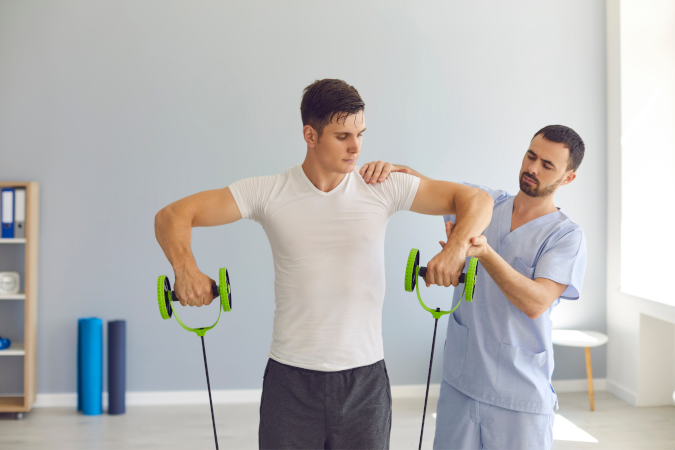
Athletic therapists also work preventively. They help athletes and active individuals learn how to avoid injury. They also help them improve their physical abilities and make their lifestyles more active. They sometimes work with the public too. For example, they may help seniors recover after surgery to replace a hip or knee.
They evaluate musculoskeletal function, posture, and gait and recognize, assess, manage, and rehabilitate musculoskeletal injuries and concussions. They also plan, implement, and supervise warm-up, flexibility, strength training, and conditioning programs for rehabilitation. Applying prophylactic or supportive taping, splinting, or bracing and providing first aid and life support in emergency are also part of their job.
Average Hourly
$29.38
Range Hourly
$17.16 – $34.25
Average Yearly
$57,291
Range Yearly
$33,465 – $66,791
Other Professional Occupations In Therapy And Assessment (3144)
Athletic trainer – therapy; Certified athletic therapist (CAT)
Athletic therapists require a bachelor's degree in sport therapy or a degree in health sciences with a specialization in sports injury management.
Average hourly |
Range hourly |
Average yearly |
Range yearly |
$29.38 |
$17.16 - $34.25 |
$57,291 |
$33,465 - $66,791 |
High
Employment outlook is good to fair across provinces. More information is available here.
Advancement in research, education, and clinical practice is possible.
2-4 years
In addition to completing a Bachelor’s degree, Athletic Therapists must complete the Athletic Therapy program at one of eight CATA-accredited institutions in Canada, including on-field and in-clinic practical training. For example:
BSc. Athletic Therapy at Concordia University
Advance Certificate in Athletic Therapy at Mount Royal University (This 2 year diploma course is for those who already have BSc. in a related filed such as kinesiology, physical education, sport medicine, exercise science or other related fields)
Bachelor of Health and Physical Education (Athletic Therapy) at Mount Royal University
Bachelor of Applied Health Sciences – Athletic Therapy at Sheridan College
Bachelor of Kinesiology – Athletic Therapy at University of Manitoba
Excellent communication skills; empathetic; ability to work independently, Patience, Flexibility, Organizational skills and attention to detail; Manual dexterity; teamwork; self-confidence; leadership skills; tech savvy; creativity and adaptability; Excellent physical and mental stamina
Not regulated
The work can be physically demanding. Athletic therapists may do exercises with their clients. They may need to move or lift patients who cannot exercise alone.
Research may involve long hours of studying computer output, collecting data, and monitoring exercise programs.
Difference between Athletic therapist and Kinesiologist
These two are very closely related.
Kinesiologist, study the science of human movement, performance and function, and incorporates the sciences of biomechanics, anatomy, physiology, psychology and neuroscience. Requires 4 year university undergraduate degree in Kinesiology, or related field (Human Kinetics, Physical Education, etc.) and after registration they have a designation of R. Kin.
Athletic Therapist can do the same job as Kinesiologist with advanced skills and must have the first-aid, BLS, EMR certificates and related skills. They have to be ready to be able to provide immediate treatment to a serious injury of an athlete in field, in addition to have the capacity to provide a short-terma nd long-term treatment/recovery plan for them. There are only eight CATA-accredited institutions where one can earn the degree.
Get a First Aid and Basic Life Support (BLS), or CATA-approved equivalent
Get a First Responders certificate or CATA-approved equivalent
Complete an Athletic Therapy program at a CATA-accredited educational school
Complete the National Certification Examination within 2 years of graduating from an accredited institution
- I
MGs may try to get into the Advance Certificate in Athletic Therapy at Mount Royal University for a fast-track entry into this career. (Especially IMGs who have previous background in Physical/Sports Medicine)